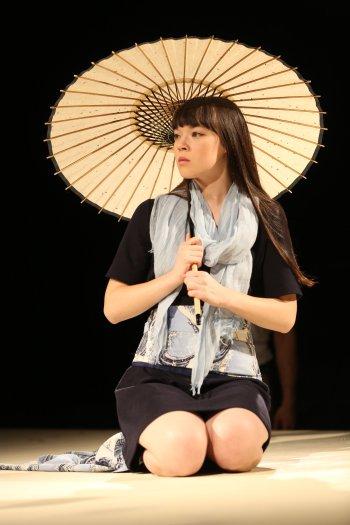Pacific Overtures
Director John Doyle’s minimalist style makes the Sondheim/Weidman musical effectively resemble Japanese prints in this scaled-down and abridged version.

Kelvin Moon Loh, Austin Ku, George Takei, Marc Oka and Thom Sesma in a scene from “Pacific Overtures” (Photo credit: Joan Marcus)
[avatar user=”Victor Gluck” size=”96″ align=”left” ] Victor Gluck, Editor-in-Chief[/avatar]Having staged a vest-pocket version of Stephen Sondheim’s 1995 Passion last season at Classic Stage Company, John Doyle has now tried a similar approach to the epic 1976 Pacific Overtures. While the results on the stage of CSC will not please everyone, the minimalist approach has the effect of making the musical look like a series of Japanese prints, its very sparseness revealing a beauty of its own. The all-Asian cast of ten led by George Takei as The Reciter brings an unmistakable authority to their roles, while the basically modern dress production resembles Noh or Kabuki drama in its stately, unemotional telling of its tale.
The playing space designed by Doyle is a narrow white runway with a stool at one end and at the other, an archway created by continuing the flooring into the air on which Japanese writing appears as on a banner. The audience sits in stadium-type seating on either side of the playing space. Eschewing pageantry, the production puts the cast in very bland outfits of black, grey, white, blue or beige (costumes by Ann Hould-Ward), adding fabric or robes when absolutely necessary. The lighting by Jane Cox occasionally bathes the stage in either red or blue mood lights.
When the performance begins, Takei as the narrator of the tale can be heard but not seen. Except for Takei and three additional actors, all the others play more than one role. While the show has been cut down to a brisk 90 minutes, all of the songs have been retained except for “Chrysanthemum Tea,” “March to the Treaty House,” and “Lion Dance.” Sondheim’s songs vary from Japanese inflected musings to Broadway style production numbers.

Megan Masako Haley in a scene from “Pacific Overtures” (Photo credit: Joan Marcus)
Depicting the story of the opening of Japan to Western commerce, Pacific Overtures is told entirely from the Japanese point of view. As Takei reminds us, westerners had been driven out in 1633 and this state of affairs continued until July 1853. The story begins when Manjiro, a fisherman who has returned from America, is hauled before Lord Abe, first councilor to the Shogun, for violating Japanese laws of both leaving and returning from a foreign land. However, he has returned to give a warning that an American expedition of four warships is on its way to Japan.
In order to deal with the crisis, Kayama, a minor samurai, is elevated to the post of Prefect of Police for the city of Uraga. When the American officers demand to see the top man, he dresses Manjiro up as a great counselor but Commodore Perry demands to deliver his letter from President Fillmore on land. In order to keep the law that no foreigner may step on Japanese soil, Kayama devises a plan to cover the sand at Kanagawa with mats and build a special treaty house for the meeting, a building that could be destroyed after the letter has been delivered. For this, Kayama is made governor of the city of Uraga.
Unfortunately for him and Japan, the great western powers all want trade agreements. This leads to misunderstandings between the western diplomats and visiting sailors off of their ships. The samurais take matters into their own hands which works to the advantage of the young, weak Emperor who has stayed out of the negotiations. Skipping ahead to the present is a reminder of all of the items we now obtain from Japan. The opening of Japan may have been an act of Western coercion but look who has had the last laugh now.

Thom Sesma, Megan Masako Haley, George Takei and Marc Oka in a scene from “Pacific Overtures” (Photo credit: Joan Marcus)
While the script by John Weidman, with additional material by Hugh Wheeler, drips with irony, Doyle’s direction is impassive and underplayed like Japanese classical theater. However, there are various memorable musical sequences that stand out: Karl Josef Co (Fisherman) and Marc Oka (Thief) in “Four Black Dragons” (the description of the US warships’ arrival in port), Steven Eng (Kayama) and Orville Mendoza (Manjiro) in their rendition of “I Will Make a Poem,” Ann Harada’s “Welcome to Kanagawa” (advice from the proprietor of a geisha house), “Please Hello!” performed by Co, Austin Ku, Oka, Kelvin Moon Loh, and Harada as the admirals of five competing countries, Eng’s witty, “A Bowler Hat” recounting the social changes brought about in Japan through the continuing events of Kayama’s life, and the lovely, “Pretty Lady,” sung by Co, Loh and Ku as three British tars on shore leave.
Jonathan Tunick’s new orchestrations conducted by music director Greg Jarrett have a haunting series of solos. In fact, the entire production has spare moments that sing out at the viewer. John Doyle’s Pacific Overtures is a challenging evening in the theater, not for those looking for light entertainment or a colorful stage filled with gorgeous sets and costumes. However, its small pleasures and spare moments inspired by Japanese art will surely stay with you once you have witnessed them.
Pacific Overtures (extended through June 18, 2017)
Classic Stage Company, 136 E. 13th Street, in Manhattan
For tickets, call 866-811-4111 or visit http://www.classicstage.org
Running time: 90 minutes with no intermission






Leave a comment